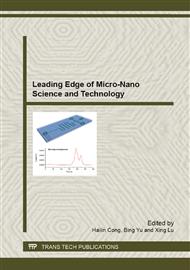p.208
p.217
p.221
p.226
p.233
p.239
p.246
p.250
p.257
Synergistic Effect of Nano Fe2O3 on Intumescent Flame Retardant Polypropylene Systems
Abstract:
Nano Fe2O3 were added into polypropylene (PP) / ammonium polyphosphate (APP) / melamine phosphate (MPOP) / 1-oxo-4-hydroxymethyl-2,6,7-trioxal-phosphabicyclo-[2.2.2]octane (PEPA) to prepare intumescent flame-retarded nanocomposites. The flame retardance and thermal stabilization and intumescent char layer have been investigated by UL-94 test, TGA and SEM. Result showed that the behavior of this intumescent system can be enhanced significantly by the addition of small amounts of nano Fe2O3. TGA results present higher thermal stability of the PP-IFR-Fe2O3 in high temperature when compared with the PP-IFR. SEM indicated the char layer from the PP-IFR-Fe2O3 system has a compact and tough char structure compared with the PP-IFR. Adding 0.3 wt% and 27 wt% IFR into PP, the PP-IFR-Fe2O3 system provided good fire retardant behavior, mechanical properties and achieved UL94 V-0 rating.
Info:
Periodical:
Pages:
233-238
Citation:
Online since:
March 2013
Authors:
Price:
Сopyright:
© 2013 Trans Tech Publications Ltd. All Rights Reserved
Share:
Citation:


